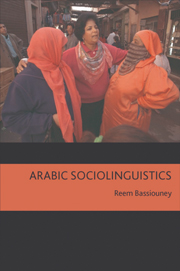Book contents
- Frontmatter
- Contents
- Acknowledgements
- List of charts, maps and tables
- List of abbreviations
- Conventions used in this book
- Introduction
- 1 Diglossia and dialect groups in the Arab world
- 2 Code-switching
- 3 Language variation and change
- 4 Arabic and gender
- 5 Language policy and politics
- General conclusion
- Bibliography
- Index
2 - Code-switching
Published online by Cambridge University Press: 05 August 2013
- Frontmatter
- Contents
- Acknowledgements
- List of charts, maps and tables
- List of abbreviations
- Conventions used in this book
- Introduction
- 1 Diglossia and dialect groups in the Arab world
- 2 Code-switching
- 3 Language variation and change
- 4 Arabic and gender
- 5 Language policy and politics
- General conclusion
- Bibliography
- Index
Summary
Language duality is not a problem but an innate ability. It is an accurate reflection of a duality that exists in all of us, a duality between our mundane daily life and our spiritual one.
Najīb Maḥfūẓ, Nobel Prize winner for literature 1988, in a letter to Luwīs ‘AwaḍAlthough he is referring here to the duality between ECA and MSA – what Ferguson calls diglossia – Maḥfūẓ touches upon one of the main functions of language choice. He does not think that duality or bilingualism in general is an impairment. In fact, it is an enriching ability that all humans possess and that enables them to express themselves differently and express their diverse needs. He echoes what Myers-Scotton discusses in her book Social motivations for code switching (1993). She refers to code-switching as part of the ‘communicative competence’ of a speaker, which is the competence that individuals acquire from their community and which enables them to communicate effectively with other members of their community. This will be discussed in detail below. Note that Maḥfūẓ does not limit ‘language duality’ to a diglossic community or a bilingual one. In this chapter I will discuss code choice and code-switching, whether this code is a variety or a language. After an introduction and discussion of terminology (sections 2.1–2.3), the chapter falls into two main parts.
- Type
- Chapter
- Information
- Arabic Sociolinguistics , pp. 28 - 87Publisher: Edinburgh University PressPrint publication year: 2009



